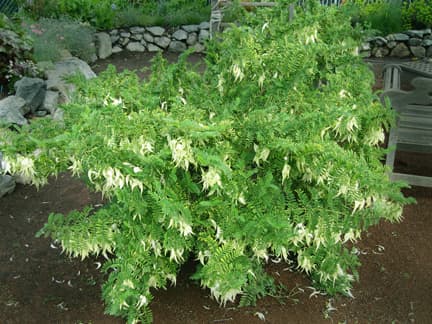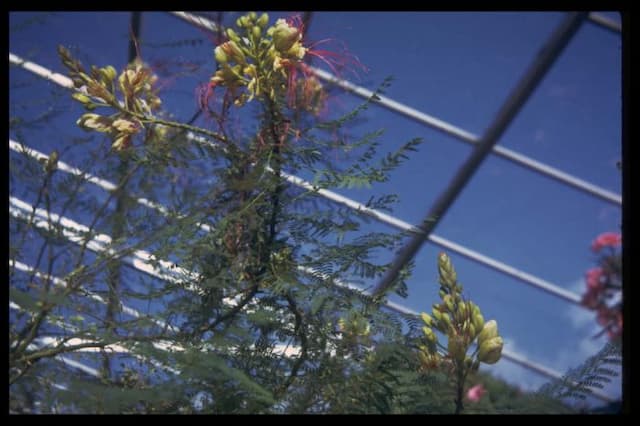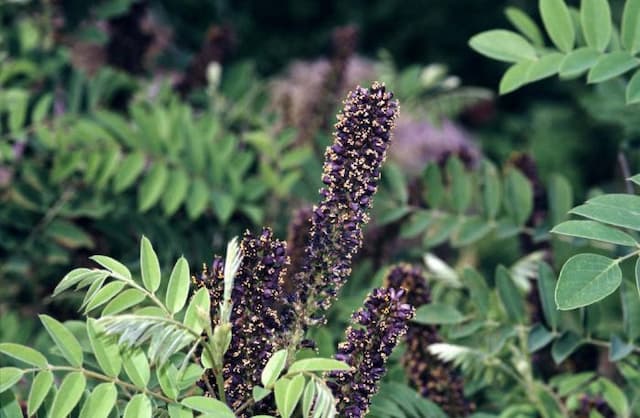Chickpea milkvetch Astragalus cicer






ABOUT
The plant commonly known as chickpea milkvetch is a perennial herb with a bushy appearance. It has compound leaves which are generally pinnate, meaning they have multiple leaflets arrayed along a central stem. The leaflets are typically green, often with a slightly greyish tint, giving the plant a muted appearance. Its flowers are pea-like in shape, arranged in dense clusters. The individual blossoms are usually a pale lavender to creamy white color, contributing to the plant's soft aesthetic. The fruit of chickpea milkvetch is a pod, which encases its seeds. These pods are somewhat inflated and can have a velvety texture. The roots of the plant are capable of nitrogen fixation, which enriches the soil and helps the plant thrive in less fertile conditions. Overall, without discussing its size, chickpea milkvetch presents as a dense, leafy plant with delicate pea-like flowers and seed pods that resemble those of the common pea plant.
About this plant
 Names
NamesFamily
Fabaceae
Synonyms
Chickpea Milk-Vetch, Cicercula, Cicer Milkvetch
Common names
Astragalus cicer L.
 Toxicity
ToxicityTo humans
Chickpea milkvetch (Astragalus cicer) is not commonly known for being toxic to humans. However, there are species in the genus Astragalus that can be hazardous and contain compounds such as swainsonine or certain alkaloids, which can cause poisoning if consumed in large enough quantities. Generally, these can lead to symptoms like nausea, vomiting, diarrhea, and in severe cases, may affect the nervous system leading to confusion or seizures. As with any wild plant, caution should be taken, and it should not be consumed unless it is known to be safe and identified accurately.
To pets
Chickpea milkvetch (Astragalus cicer) is generally not considered highly toxic to pets, but it is important to note that there are species within the Astragalus genus that can be harmful if ingested. Some Astragalus species may contain toxic alkaloids, which can affect animals, particularly grazing livestock like horses or cattle, if they consume a large amount of these plants. Signs of toxicity can include gastrointestinal upset, lethargy, and in some cases, more serious neurological signs such as difficulty walking or muscle tremors. It is always best to prevent pets from consuming unknown plants and to consult a veterinarian if any unusual symptoms arise after ingestion.
 Characteristics
CharacteristicsLife cycle
Perennials
Foliage type
Deciduous
Color of leaves
Green
Flower color
Yellow
Height
1-2 feet (0.3-0.6 meters)
Spread
2-3 feet (0.6-0.9 meters)
Plant type
Herb
Hardiness zones
3
Native area
Europe
Benefits
 General Benefits
General Benefits- Nitrogen Fixation: Chickpea milkvetch has the ability to fix atmospheric nitrogen, enriching the soil and reducing the need for synthetic fertilizers.
- Erosion Control: Its root system helps stabilize the soil and prevent erosion.
- Forage: It provides nutritious forage for livestock and is palatable to a variety of grazing animals.
- Drought Tolerance: Chickpea milkvetch is resilient under dry conditions, making it valuable for land management in arid regions.
- Biodiversity: It supports a variety of wildlife, serving as a habitat and food source for insects and other animals.
- Soil Health: The plant contributes to soil health by improving soil structure and fertility.
- Cover Crop: It can be used as a cover crop to suppress weeds and protect soil from direct sunlight.
 Medical Properties
Medical Properties- Immunomodulatory: Astragalus cicer, commonly known as Chickpea Milkvetch, is believed by some to have properties that can modulate the immune system.
- Antioxidant: Some studies suggest that extracts from the plant may have antioxidant effects.
- Anti-inflammatory: The plant is thought to potentially have anti-inflammatory components.
- Antiviral: There is some belief that Chickpea Milkvetch can have antiviral effects, though the data is not concrete.
- Adaptogenic: Traditionally, it might be used to help the body resist stressors of various kinds, though this use is not well-documented in scientific literature.
 Air-purifying Qualities
Air-purifying QualitiesThis plant is not specifically known for air purifying qualities.
 Other Uses
Other Uses- Astragalus cicer, also known as chickpea milkvetch, has been studied for its properties as a natural dye; the root of the plant can produce a yellow dye used in textile coloring.
- The plant's fibers have been considered for use in making paper due to the fibrous nature of its stems.
- Chickpea milkvetch can be utilized as a soil stabilizer because its root system helps prevent erosion and improves soil structure.
- The plant has potential in phytoremediation for the removal of heavy metals from contaminated soils because it is a hardy perennial that can tolerate different soil conditions.
- Gardeners use chickpea milkvetch as a cover crop to fix nitrogen in the soil, thereby improving fertility for future plantings.
- It can be integrated into animal grazing systems as a forage crop because it is high in protein and nutrients beneficial for livestock.
- Chickpea milkvetch serves an ecological role in supporting beneficial insects, providing a habitat for pollinators such as bees.
- It is sometimes planted in wildflower mixes to enhance biodiversity and aesthetic value in naturalized landscape settings.
- Farmers may use chickpea milkvetch as a green manure, plowing it into the soil to act as a nutrient-rich organic compost material.
- As part of companion planting strategies, it can be grown alongside other crops to improve overall growth conditions through symbiotic relationships.
Interesting Facts
 Feng Shui
Feng ShuiChickpea is not used in Feng Shui practice.
 Zodiac Sign Compitability
Zodiac Sign CompitabilityChickpea is not used in astrology practice.
 Plant Symbolism
Plant Symbolism- Protection: Astragalus cicer, commonly known as Chickpea Milk-vetch, has been traditionally used as a herbal remedy, thought to provide protective health benefits, strengthening the immune system.
- Healing: Reflecting its use in traditional medicine, the Chickpea Milk-vetch represents healing, particularly in the context of its roots which are used in various cultures to make medicinal tonics.
- Longevity: Due to its association with vitality and health in herbal practices, Chickpea Milk-vetch is often symbolized with a long and healthy life.
- Endurance: The plant's ability to thrive in poor soil conditions signifies endurance and resilience, making it a symbol for overcoming adversity.
 Water
WaterChickpea milkvetch should be watered deeply yet infrequently, allowing the soil to dry out partially between watering sessions. In general, it is advisable to provide about 1 inch of water per week, keeping in mind that this amount may fluctuate based on temperature and soil conditions. Overwatering can lead to root rot, so ensure that the plant has well-draining soil. During the growing season, monitor the soil moisture regularly, and reduce watering in the winter when the plant is not actively growing.
 Light
LightChickpea milkvetch thrives in full sun conditions, meaning it prefers to receive at least six hours of direct sunlight each day. Planting it in a spot where it can bask in unobstructed sunlight will ensure optimal growth. While it can tolerate some partial shade, too little light may impede its growth and flower production.
 Temperature
TemperatureChickpea milkvetch is fairly tolerant of temperature fluctuations and can survive in temperatures as low as 10 degrees Fahrenheit. However, it grows best in temperatures ranging between 60 and 70 degrees Fahrenheit. Extreme cold or heat can be detrimental, so it's important to plant Chickpea milkvetch in an area that avoids the harshest temperatures.
 Pruning
PruningPruning Chickpea milkvetch can encourage bushier growth and improve air circulation among the leaves. It's best to prune during the dormant season, in late winter or early spring before new growth begins. Remove any dead or damaged stems and shape the plant as desired, trimming it back by about one third. Annual pruning can also rejuvenate older plants and maintain a tidy appearance.
 Cleaning
CleaningAs needed
 Soil
SoilCicer milkvetch thrives in a well-draining soil mix with a neutral to slightly alkaline pH, ideally between 7.0 and 8.0. A blend of garden soil, compost, and sand or perlite can create a suitable growing medium for healthy root development.
 Repotting
RepottingCicer milkvetch does not need to be repotted frequently and can typically be replanted every two to three years, depending on the growth rate and the size of the container.
 Humidity & Misting
Humidity & MistingCicer milkvetch is tolerant of a wide range of humidity levels but performs best under moderate conditions, avoiding extremely dry or highly humid environments.
 Suitable locations
Suitable locationsIndoor
Ensure full sun and well-draining soil in a large pot.
Outdoor
Plant in full sun, in well-drained soil; tolerate cold.
Hardiness zone
3-8 USDA.
 Life cycle
Life cycleAstragalus cicer, commonly known as Chickpea Milk-vetch, begins its life cycle as a seed, which upon favorable conditions germinates in the spring to produce a small seedling with a primary root that will develop into a taproot. The seedling grows into a vegetative plant with compound leaves and a robust stem, establishing a rosette as it matures. During its flowering stage, usually in late spring to summer, it develops racemes of pea-like flowers which are predominantly yellowish-white to cream in color. After pollination, typically by bees and other insects, these flowers develop into seed pods that elongate and contain multiple seeds. The plant then undergoes senescence in late summer or fall, wherein the above-ground parts die back, and the seeds are dispersed, often entering a period of dormancy through the colder months. This plant is a perennial, and its root system can survive winter to give rise to new growth in the subsequent spring, thus continuing its life cycle.
 Propogation
PropogationPropogation time
Spring-early summer
Chickpea milkvetch, or Astragalus cicer, is primarily propagated through seed. The ideal time for sowing seeds is in the spring after the threat of frost has passed. Initially, seeds may have a hard, impermeable coat, which can be overcome by scarification—nicking or rubbing the seeds between sandpaper to allow moisture to penetrate. Once scarified, the seeds should be sown approximately 1 inch (2.54 centimeters) deep into the soil. This species can benefit from inoculation with rhizobium bacteria to promote nitrogen fixation. Adequate watering is essential until the seeds germinate and establish, but once established, the plants become quite drought tolerant. Care should be taken not to overwater, as this can lead to root rot.








